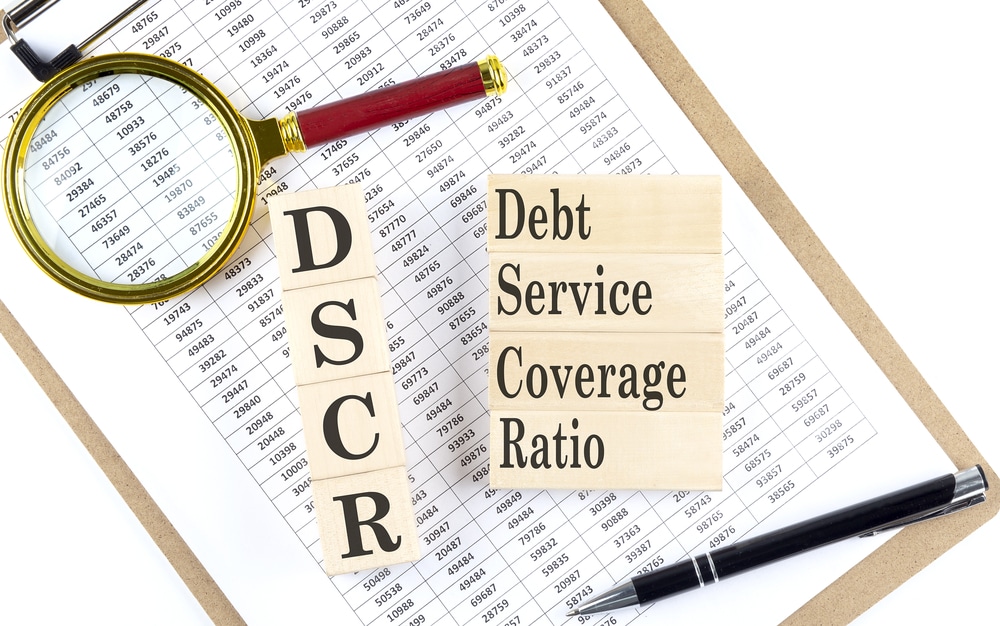You’ve heard about DSCR loans and the Debt-Service Coverage Ratio (DSCR), but what exactly are they, and why should you care?
In this blog, we’ll break down the fundamentals of DSCR loans, explain the DSCR ratio, and delve into the importance of understanding your repayment options and strategies.
What Are DSCR Loans and Why Are They Important?
DSCR loans, also known as Debt-Service Coverage Ratio loans, are a type of financing specifically designed for businesses and individuals looking to borrow money while considering their ability to repay the loan.
These loans take into account the borrower’s cash flow and financial stability, ensuring that they can comfortably manage their debt payments.
Why are DSCR loans important? Well, they provide a more realistic assessment of a borrower’s ability to repay a loan compared to traditional loans.
By factoring in the borrower’s income and other financial obligations, DSCR loans promote responsible lending and help borrowers avoid taking on more debt than they can handle.
Understanding DSCR Loans
Understanding the Debt-Service Coverage Ratio
The Debt-Service Coverage Ratio, often referred to as the DSCR ratio, is a key component of DSCR loans. This ratio measures a borrower’s ability to meet their debt obligations by comparing their net operating income to their total debt service payments.
In simple terms, the DSCR ratio assesses whether a borrower has enough cash flow to comfortably cover their loan payments.
A higher DSCR ratio indicates a better ability to repay the loan, while a lower ratio may signal a higher risk of default.
Know Your DSCR Loan Repayment Options and Strategies
Now, here’s the critical part: understanding your DSCR loan repayment options and strategies.
It’s not just about getting approved for the loan; it’s about successfully managing the repayment process.
- By familiarizing yourself with various repayment options and strategies, you can make informed decisions that align with your financial situation and goals.
- Knowing your repayment options allows you to choose a payment plan that suits your preferences and cash flow.
It could be a fixed payment plan, where you make consistent monthly payments, or a variable payment plan that provides flexibility in adjusting your payments based on your income fluctuations.
Additionally, interest-only payments can be a temporary relief, allowing you to focus on cash flow without reducing the principal balance.
Moreover, understanding repayment strategies empowers you to optimize your finances. Effective cash flow management, debt consolidation, and refinancing are some strategies that can help you stay on top of your loan payments and potentially save money in the long run.
Meeting the Requirements and Qualifications for DSCR Loans
To qualify for a DSCR loan, borrowers must meet specific requirements and qualifications. Lenders typically look for the following criteria:
 Debt-Service Coverage Ratio (DSCR): Lenders generally require a minimum DSCR ratio, usually around 1.2 or higher. This means that the borrower’s net operating income should be 1.2 times or more than the total debt service payments.
Debt-Service Coverage Ratio (DSCR): Lenders generally require a minimum DSCR ratio, usually around 1.2 or higher. This means that the borrower’s net operating income should be 1.2 times or more than the total debt service payments.- Creditworthiness: While DSCR loans prioritize cash flow, borrowers’ creditworthiness still plays a role. Lenders consider credit scores and credit history to assess the borrower’s overall financial health and reliability.
- Property Evaluation: The property serving as collateral for the loan undergoes evaluation to determine its value, income potential, and condition. Lenders want to ensure that the property can generate sufficient income to support the loan payments.
- Documentation: Borrowers need to provide various documents, including financial statements, tax returns, lease agreements (if applicable), and other relevant paperwork to support their loan application.
How DSCR Loans Differ from Traditional Loans
DSCR loans differ from traditional loans in several ways:
- Cash Flow Focus: DSCR loans prioritize the borrower’s cash flow and ability to meet debt obligations using the DSCR ratio. Traditional loans typically rely heavily on creditworthiness, collateral, and other factors.
- Property Evaluation: DSCR loans often involve a thorough evaluation of the property’s income potential and value, as it plays a crucial role in assessing loan eligibility. Traditional loans may focus more on the borrower’s personal financial situation.
- Risk Assessment: DSCR loans aim to mitigate risk by ensuring borrowers can comfortably repay their debt. Traditional loans may have a broader risk assessment approach that considers multiple factors.
The Benefits and Risks of Dscr Loans for Borrowers
DSCR loans offer several benefits for borrowers:
- Realistic Loan Assessment: DSCR loans provide a more accurate assessment of a borrower’s ability to repay the loan by considering their cash flow. This helps prevent borrowers from taking on excessive debt and potential financial strain.
- Favorable Loan Terms: Since DSCR loans are tailored to the borrower’s ability to repay, they may offer more favorable terms, such as lower interest rates or longer repayment periods.
- Financing for Income-Producing Properties: DSCR loans are specifically designed for investments in income-generating properties, making them a suitable option for borrowers looking to expand their real estate portfolio.
However, borrowers should also be aware of potential risks associated with DSCR loans:
- Stricter Requirements: DSCR loans often have more stringent eligibility criteria compared to traditional loans, requiring borrowers to meet specific financial benchmarks.
- Property as Collateral: If borrowers fail to meet their loan obligations, the lender may have the right to seize the income-producing property used as collateral, posing a potential risk to the borrower’s investment.
Payment Options for DSCR Loan Repayment
DSCR loans typically come with flexible payment options that cater to a borrower’s individual needs. Here are some of the most common repayment plans:
Fixed Payment Plan: Keeping It Consistent
With a fixed payment plan, borrowers make regular, consistent payments throughout the loan term.
These payments typically include both principal and interest, ensuring a steady reduction of the debt balance over time.
Pros
- Predictability: Fixed payment plans provide stability and predictability since the payment amount remains the same throughout the loan term.
- Budgeting: Borrowers can easily budget and plan their finances around the fixed payment amount, making it easier to manage their cash flow.
Cons
- Potential Higher Initial Payments: Initially, the fixed payment amount may be higher than other payment options, which could impact cash flow in the short term.
- Limited Flexibility: Fixed payment plans offer less flexibility in adjusting payments to accommodate changes in income or financial circumstances.
Variable Payment Plan: Flexibility at Play
Variable payment plans allow borrowers to adjust their loan payments periodically based on changes in their cash flow.
These adjustments could be due to fluctuations in income, seasonal variations, or other financial factors.
Pros
- Flexibility: Borrowers have the flexibility to increase or decrease their payments based on their financial situation, allowing for better cash flow management.
- Potential Interest Savings: When borrowers have surplus funds, they can allocate them towards larger payments, potentially reducing the overall interest paid over the loan term.
Cons
- Uncertainty: The variability of payment amounts can make it more challenging to plan and budget for loan repayment, as the payment amounts may change periodically.
- Higher Interest Costs: If borrowers consistently make lower payments during periods of reduced cash flow, the overall interest paid over the loan term may increase.
Interest-Only Payments: Temporarily Easing The Load
With interest-only payments, borrowers have the option to make payments that cover only the interest portion of the loan.
This means the principal balance remains unchanged during the interest-only period, typically for a specific duration agreed upon with the lender.
Pros
- Lower Initial Payments: Interest-only payments can provide temporary relief by reducing the initial payment amount, allowing borrowers to manage their cash flow more effectively during the specified period.
- Potential Investment Opportunities: By making lower payments, borrowers may have the opportunity to allocate their funds toward other investments or income-generating ventures.
Cons
- Extended Loan Term: Since interest-only payments do not contribute to reducing the principal balance, the loan term may be extended. This means borrowers will have to make larger payments in the future to fully repay the loan.
- Higher Overall Interest Costs: With interest-only payments, borrowers will pay more in interest over the loan term compared to other payment options, as the principal balance remains untouched for a significant period.
Strategies for Repaying DSCR Loans
Borrowers who take out DSCR loans should consider the following strategies to ensure they meet their loan obligations and maximize returns on investment:
-
 Cash Flow Management
Cash Flow ManagementMonitoring your cash flow is crucial when repaying DSCR loans. It allows you to have a clear understanding of your income, expenses, and available funds to ensure timely loan payments.
Practical tips for effective cash flow management:
- Create a detailed budget: Track your income and expenses to identify areas where you can reduce costs and allocate more funds towards loan repayment.
- Prioritize expenses: Focus on essential expenses and consider cutting back on discretionary spending to free up additional cash for loan payments.
- Automate payments: Set up automatic payments to ensure you never miss a loan payment and avoid potential late fees or penalties.
- Build an emergency fund: Having a contingency fund can provide a financial safety net in case of unexpected expenses, reducing the risk of defaulting on loan payments.
-
Debt Consolidation
Debt consolidation involves combining multiple debts into a single loan, simplifying repayment and potentially reducing monthly payments.
It can help borrowers with DSCR loans in the following ways:
- Lower interest rates: Consolidating high-interest debts into a single loan with a lower interest rate can result in savings over time.
- Streamlined repayment: Managing a single loan is often more manageable and less complicated than juggling multiple debts.
- Improved cash flow: Debt consolidation can potentially reduce monthly payments, providing borrowers with more cash flow to allocate towards DSCR loan repayment.
Steps to consolidate debt and reduce monthly payments:
- Assess your existing debts: Identify all outstanding debts, including credit cards, personal loans, or other high-interest loans.
- Research consolidation options: Explore different debt consolidation options, such as personal loans, home equity loans, or balance transfer credit cards, comparing interest rates, fees, and repayment terms.
- Apply for consolidation loan: Once you’ve chosen the most suitable consolidation option, apply for the loan and use the funds to pay off your existing debts.
- Develop a repayment plan: Create a realistic repayment plan to ensure timely repayment of the consolidation loan, prioritizing it alongside your DSCR loan.
-
Refinancing
Refinancing involves replacing an existing loan with a new loan, often with more favorable terms. Refinancing a DSCR loan can offer the following benefits:
- Lower interest rates: If interest rates have decreased since you initially obtained the loan, refinancing can help secure a lower rate, potentially reducing monthly payments.
- Adjusted loan term: Refinancing provides an opportunity to extend or shorten the loan term, depending on your financial goals and circumstances.
- Access to equity: If your property has appreciated in value, refinancing can allow you to access the equity and use it for debt repayment or other investment purposes.
The benefits and things to consider before refinancing:
- Benefits of refinancing: Reduced interest rates, improved cash flow, potential savings over the loan term, and the ability to access equity for other financial needs.
- Considerations before refinancing: Evaluate closing costs, fees, and potential prepayment penalties associated with refinancing. Also, assess your creditworthiness to determine if you qualify for more favorable loan terms.
Maximizing DSCR Loan Repayment
Determining the most effective debt repayment order:
- Assess the interest rates: Prioritize paying off debts with higher interest rates first to reduce overall interest costs.
- Consider the DSCR loan terms: Evaluate the specific terms of your DSCR loan, such as maturity date or prepayment penalties, when establishing a repayment strategy.
- Addressing high-risk debts: If you have debts with significant consequences for non-payment, such as tax liens or high-penalty loans, prioritize these for early repayment.
Balancing DSCR loan repayment with other financial obligations:
- Maintain minimum payments: Ensure you meet the minimum payment requirements for all your debts to avoid penalties and maintain a positive credit history.
- Communicate with lenders: If you encounter financial difficulties, communicate with your lenders to explore alternative repayment options or negotiate more favorable terms.
- Seek professional advice: Consult with financial advisors or credit counselors who can provide guidance on debt management strategies tailored to your specific situation.
Final Thoughts
Effectively managing DSCR loan repayment requires careful consideration of various strategies and options.
By increasing income streams through additional sources of revenue and exploring alternative investments, borrowers can boost their cash flow and allocate more funds towards loan repayment.
Prioritizing debts strategically by considering interest rates and specific loan terms helps optimize the repayment process. It is important to strike a balance between DSCR loan repayment and other financial obligations to maintain overall financial stability.
Remember, each borrower’s financial situation is unique, so it’s important to evaluate these strategies in the context of your personal circumstances.
By choosing the right repayment option and implementing effective strategies, you can take control of your DSCR loan repayment and work towards achieving your financial goals.
Take action, stay proactive, and seek professional advice when needed to ensure a successful and sustainable repayment journey.
Sprint Funding is here to help you build financial health and reach your business goals. Learn more about DSCR loans and how Sprint Funding can help you secure the financing needed to fund your next project. Get in touch with us today!





